Communication in Healthcare: A Vital Component of Patient Well-being and Health
VerifiedAdded on 2019/12/28
|11
|3269
|198
Essay
AI Summary
Effective communication is crucial in healthcare settings, as it can significantly impact patient well-being and health outcomes. The absence of communication can create medical hazards and problems within care organizations. Therefore, it is essential to foster an open and effective communication culture that encourages collaboration and cooperation among healthcare professionals, patients, and their families. This summary highlights the importance of communication in healthcare settings.
Contribute Materials
Your contribution can guide someone’s learning journey. Share your
documents today.
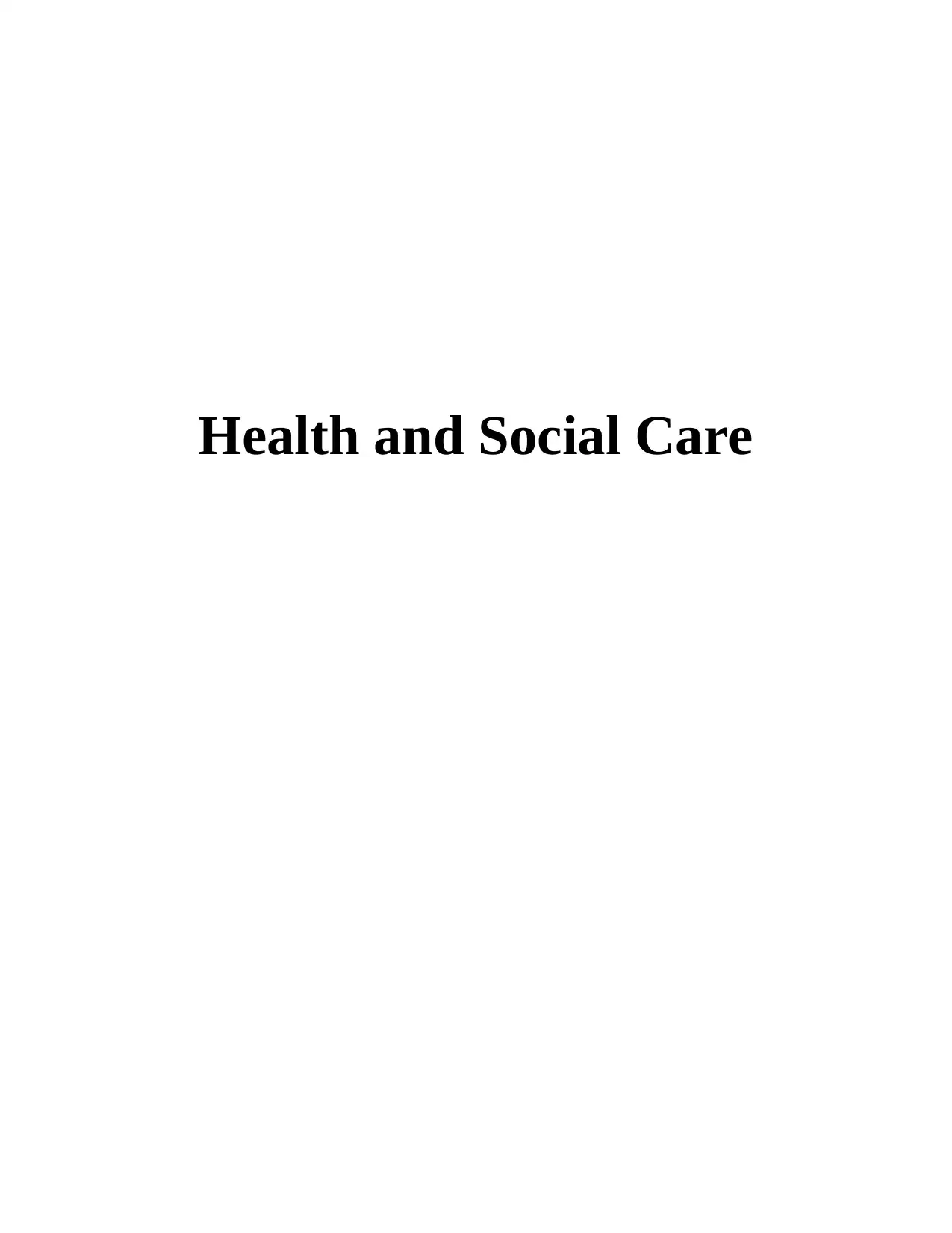
Health and Social Care
Secure Best Marks with AI Grader
Need help grading? Try our AI Grader for instant feedback on your assignments.
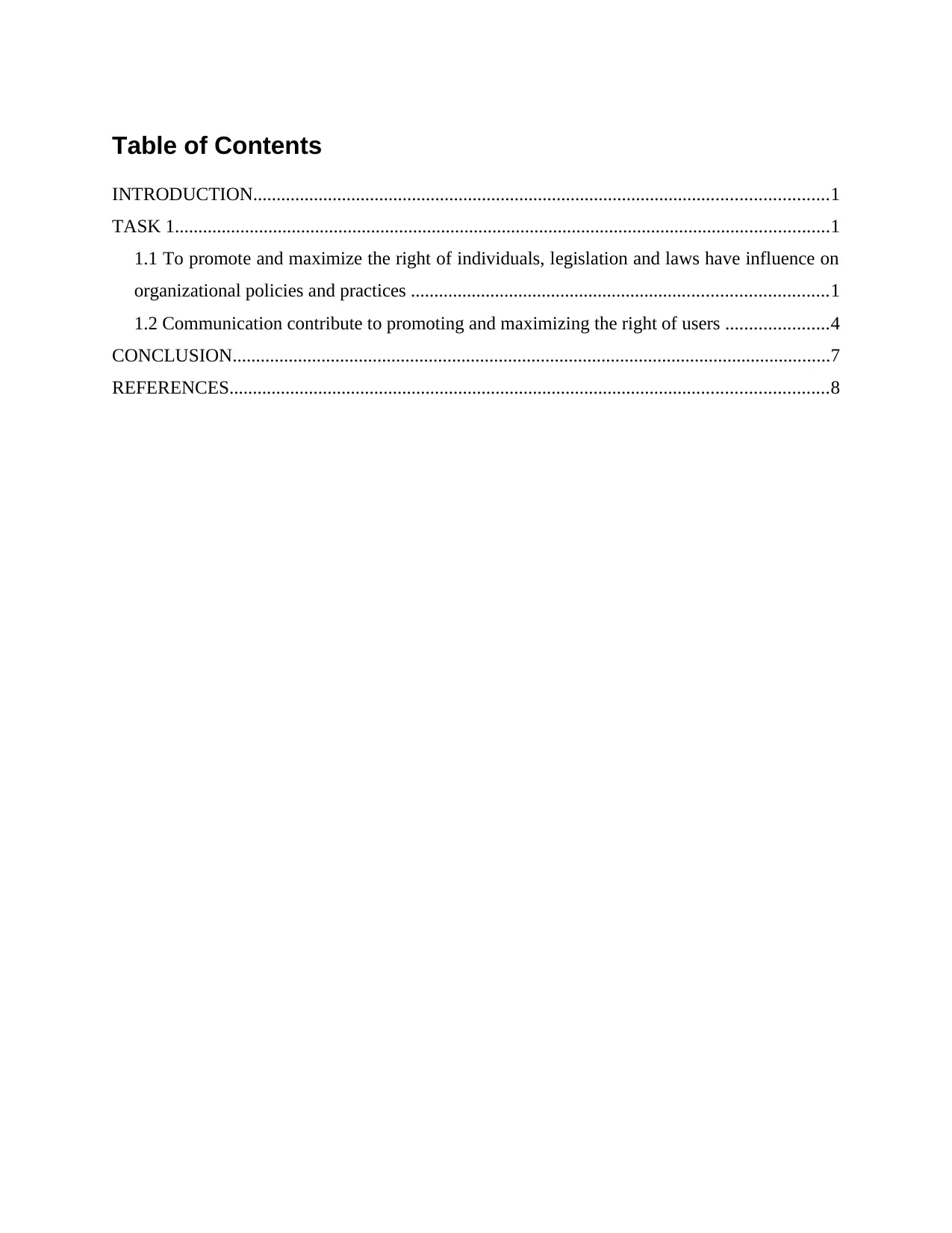
Table of Contents
INTRODUCTION...........................................................................................................................1
TASK 1............................................................................................................................................1
1.1 To promote and maximize the right of individuals, legislation and laws have influence on
organizational policies and practices .........................................................................................1
1.2 Communication contribute to promoting and maximizing the right of users ......................4
CONCLUSION................................................................................................................................7
REFERENCES................................................................................................................................8
INTRODUCTION...........................................................................................................................1
TASK 1............................................................................................................................................1
1.1 To promote and maximize the right of individuals, legislation and laws have influence on
organizational policies and practices .........................................................................................1
1.2 Communication contribute to promoting and maximizing the right of users ......................4
CONCLUSION................................................................................................................................7
REFERENCES................................................................................................................................8
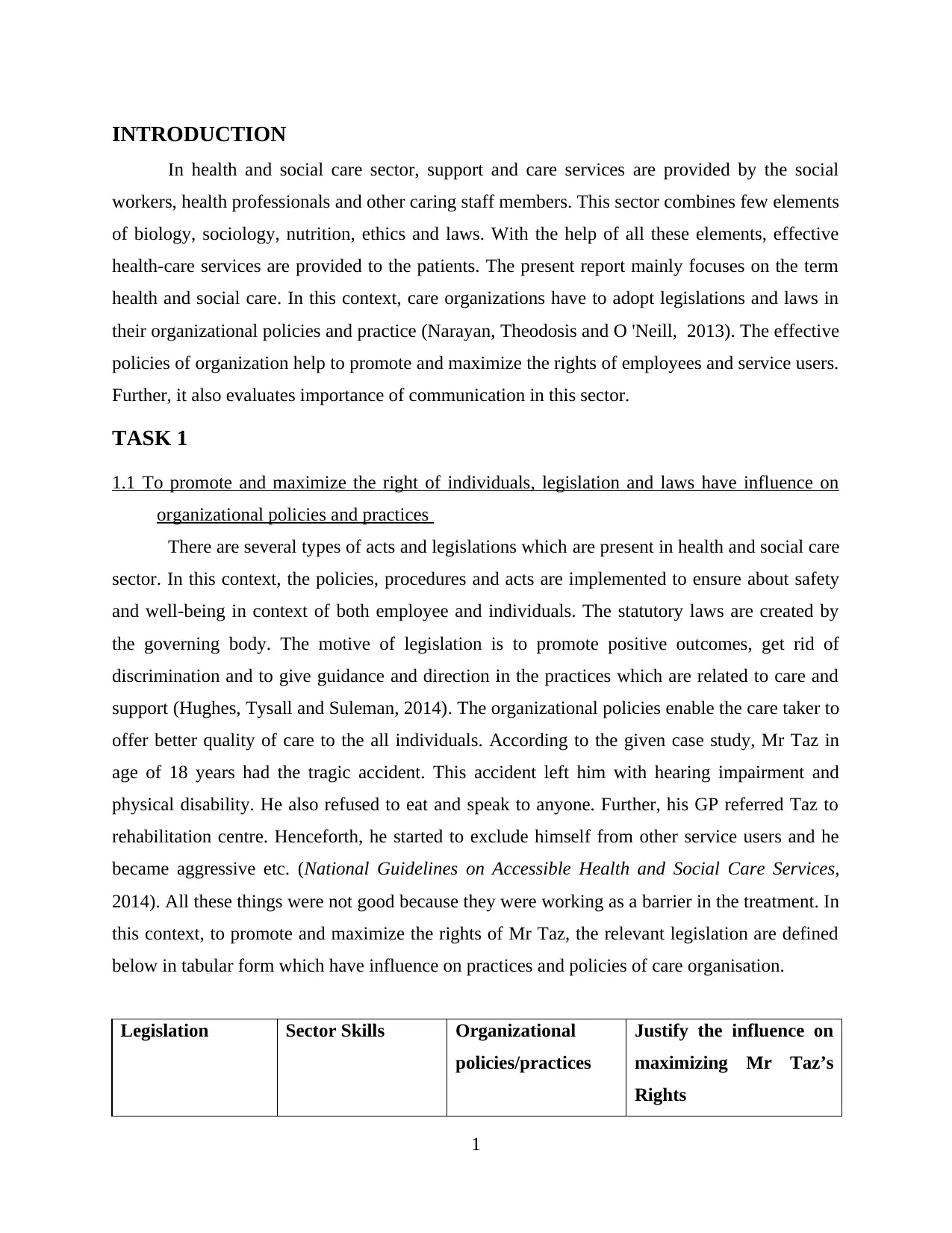
INTRODUCTION
In health and social care sector, support and care services are provided by the social
workers, health professionals and other caring staff members. This sector combines few elements
of biology, sociology, nutrition, ethics and laws. With the help of all these elements, effective
health-care services are provided to the patients. The present report mainly focuses on the term
health and social care. In this context, care organizations have to adopt legislations and laws in
their organizational policies and practice (Narayan, Theodosis and O 'Neill, 2013). The effective
policies of organization help to promote and maximize the rights of employees and service users.
Further, it also evaluates importance of communication in this sector.
TASK 1
1.1 To promote and maximize the right of individuals, legislation and laws have influence on
organizational policies and practices
There are several types of acts and legislations which are present in health and social care
sector. In this context, the policies, procedures and acts are implemented to ensure about safety
and well-being in context of both employee and individuals. The statutory laws are created by
the governing body. The motive of legislation is to promote positive outcomes, get rid of
discrimination and to give guidance and direction in the practices which are related to care and
support (Hughes, Tysall and Suleman, 2014). The organizational policies enable the care taker to
offer better quality of care to the all individuals. According to the given case study, Mr Taz in
age of 18 years had the tragic accident. This accident left him with hearing impairment and
physical disability. He also refused to eat and speak to anyone. Further, his GP referred Taz to
rehabilitation centre. Henceforth, he started to exclude himself from other service users and he
became aggressive etc. (National Guidelines on Accessible Health and Social Care Services,
2014). All these things were not good because they were working as a barrier in the treatment. In
this context, to promote and maximize the rights of Mr Taz, the relevant legislation are defined
below in tabular form which have influence on practices and policies of care organisation.
Legislation Sector Skills Organizational
policies/practices
Justify the influence on
maximizing Mr Taz’s
Rights
1
In health and social care sector, support and care services are provided by the social
workers, health professionals and other caring staff members. This sector combines few elements
of biology, sociology, nutrition, ethics and laws. With the help of all these elements, effective
health-care services are provided to the patients. The present report mainly focuses on the term
health and social care. In this context, care organizations have to adopt legislations and laws in
their organizational policies and practice (Narayan, Theodosis and O 'Neill, 2013). The effective
policies of organization help to promote and maximize the rights of employees and service users.
Further, it also evaluates importance of communication in this sector.
TASK 1
1.1 To promote and maximize the right of individuals, legislation and laws have influence on
organizational policies and practices
There are several types of acts and legislations which are present in health and social care
sector. In this context, the policies, procedures and acts are implemented to ensure about safety
and well-being in context of both employee and individuals. The statutory laws are created by
the governing body. The motive of legislation is to promote positive outcomes, get rid of
discrimination and to give guidance and direction in the practices which are related to care and
support (Hughes, Tysall and Suleman, 2014). The organizational policies enable the care taker to
offer better quality of care to the all individuals. According to the given case study, Mr Taz in
age of 18 years had the tragic accident. This accident left him with hearing impairment and
physical disability. He also refused to eat and speak to anyone. Further, his GP referred Taz to
rehabilitation centre. Henceforth, he started to exclude himself from other service users and he
became aggressive etc. (National Guidelines on Accessible Health and Social Care Services,
2014). All these things were not good because they were working as a barrier in the treatment. In
this context, to promote and maximize the rights of Mr Taz, the relevant legislation are defined
below in tabular form which have influence on practices and policies of care organisation.
Legislation Sector Skills Organizational
policies/practices
Justify the influence on
maximizing Mr Taz’s
Rights
1
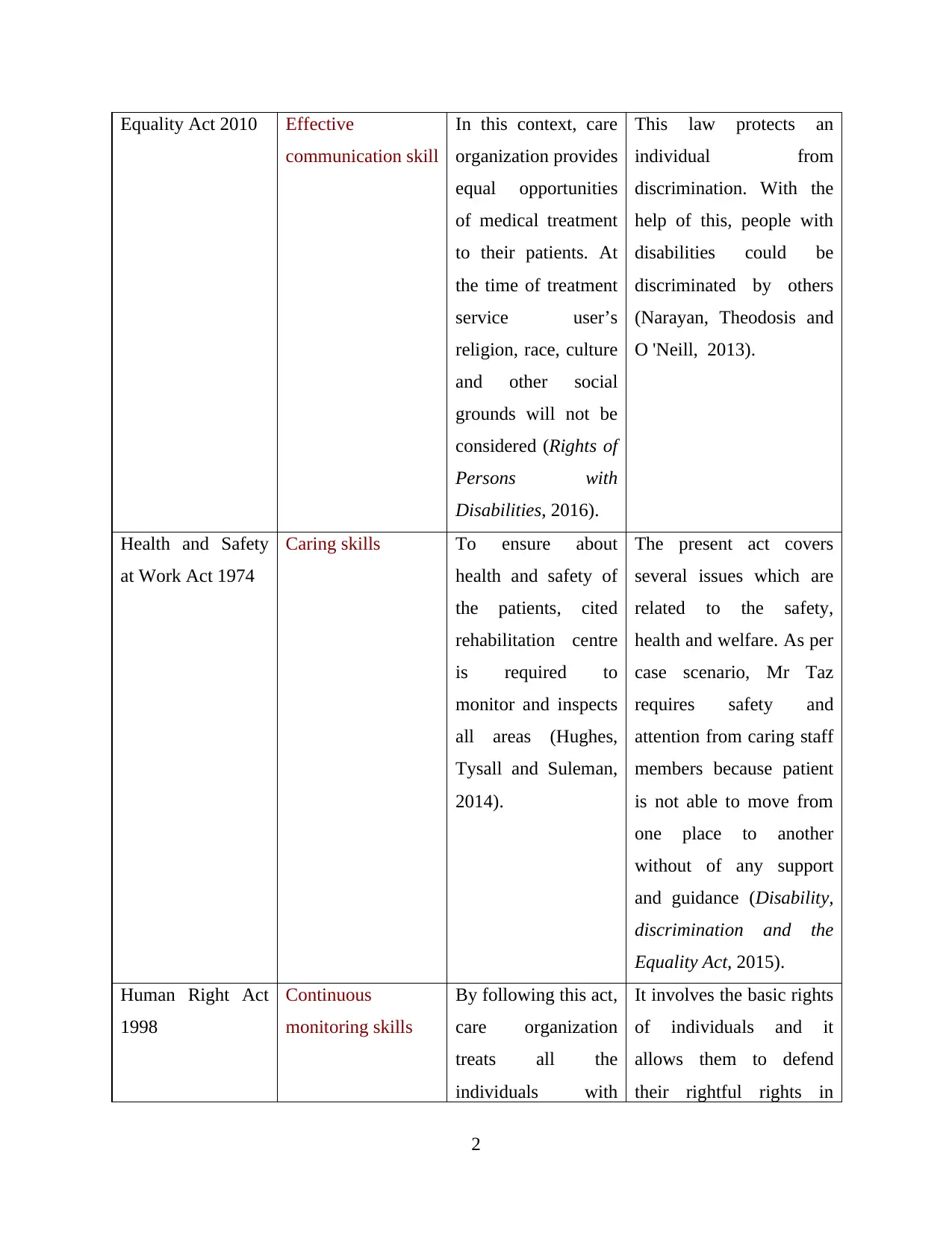
Equality Act 2010 Effective
communication skill
In this context, care
organization provides
equal opportunities
of medical treatment
to their patients. At
the time of treatment
service user’s
religion, race, culture
and other social
grounds will not be
considered (Rights of
Persons with
Disabilities, 2016).
This law protects an
individual from
discrimination. With the
help of this, people with
disabilities could be
discriminated by others
(Narayan, Theodosis and
O 'Neill, 2013).
Health and Safety
at Work Act 1974
Caring skills To ensure about
health and safety of
the patients, cited
rehabilitation centre
is required to
monitor and inspects
all areas (Hughes,
Tysall and Suleman,
2014).
The present act covers
several issues which are
related to the safety,
health and welfare. As per
case scenario, Mr Taz
requires safety and
attention from caring staff
members because patient
is not able to move from
one place to another
without of any support
and guidance (Disability,
discrimination and the
Equality Act, 2015).
Human Right Act
1998
Continuous
monitoring skills
By following this act,
care organization
treats all the
individuals with
It involves the basic rights
of individuals and it
allows them to defend
their rightful rights in
2
communication skill
In this context, care
organization provides
equal opportunities
of medical treatment
to their patients. At
the time of treatment
service user’s
religion, race, culture
and other social
grounds will not be
considered (Rights of
Persons with
Disabilities, 2016).
This law protects an
individual from
discrimination. With the
help of this, people with
disabilities could be
discriminated by others
(Narayan, Theodosis and
O 'Neill, 2013).
Health and Safety
at Work Act 1974
Caring skills To ensure about
health and safety of
the patients, cited
rehabilitation centre
is required to
monitor and inspects
all areas (Hughes,
Tysall and Suleman,
2014).
The present act covers
several issues which are
related to the safety,
health and welfare. As per
case scenario, Mr Taz
requires safety and
attention from caring staff
members because patient
is not able to move from
one place to another
without of any support
and guidance (Disability,
discrimination and the
Equality Act, 2015).
Human Right Act
1998
Continuous
monitoring skills
By following this act,
care organization
treats all the
individuals with
It involves the basic rights
of individuals and it
allows them to defend
their rightful rights in
2
Secure Best Marks with AI Grader
Need help grading? Try our AI Grader for instant feedback on your assignments.
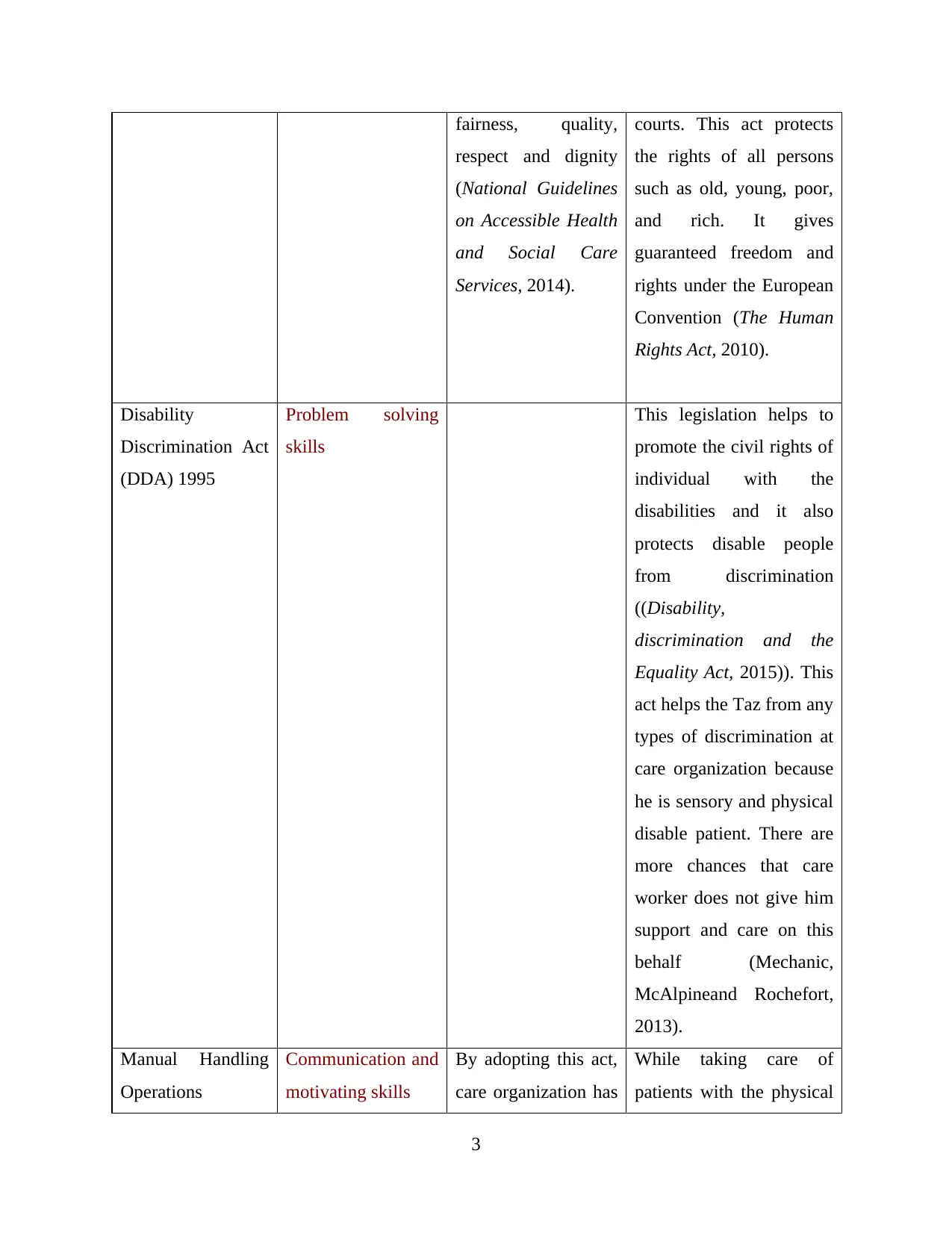
fairness, quality,
respect and dignity
(National Guidelines
on Accessible Health
and Social Care
Services, 2014).
courts. This act protects
the rights of all persons
such as old, young, poor,
and rich. It gives
guaranteed freedom and
rights under the European
Convention (The Human
Rights Act, 2010).
Disability
Discrimination Act
(DDA) 1995
Problem solving
skills
This legislation helps to
promote the civil rights of
individual with the
disabilities and it also
protects disable people
from discrimination
((Disability,
discrimination and the
Equality Act, 2015)). This
act helps the Taz from any
types of discrimination at
care organization because
he is sensory and physical
disable patient. There are
more chances that care
worker does not give him
support and care on this
behalf (Mechanic,
McAlpineand Rochefort,
2013).
Manual Handling
Operations
Communication and
motivating skills
By adopting this act,
care organization has
While taking care of
patients with the physical
3
respect and dignity
(National Guidelines
on Accessible Health
and Social Care
Services, 2014).
courts. This act protects
the rights of all persons
such as old, young, poor,
and rich. It gives
guaranteed freedom and
rights under the European
Convention (The Human
Rights Act, 2010).
Disability
Discrimination Act
(DDA) 1995
Problem solving
skills
This legislation helps to
promote the civil rights of
individual with the
disabilities and it also
protects disable people
from discrimination
((Disability,
discrimination and the
Equality Act, 2015)). This
act helps the Taz from any
types of discrimination at
care organization because
he is sensory and physical
disable patient. There are
more chances that care
worker does not give him
support and care on this
behalf (Mechanic,
McAlpineand Rochefort,
2013).
Manual Handling
Operations
Communication and
motivating skills
By adopting this act,
care organization has
While taking care of
patients with the physical
3
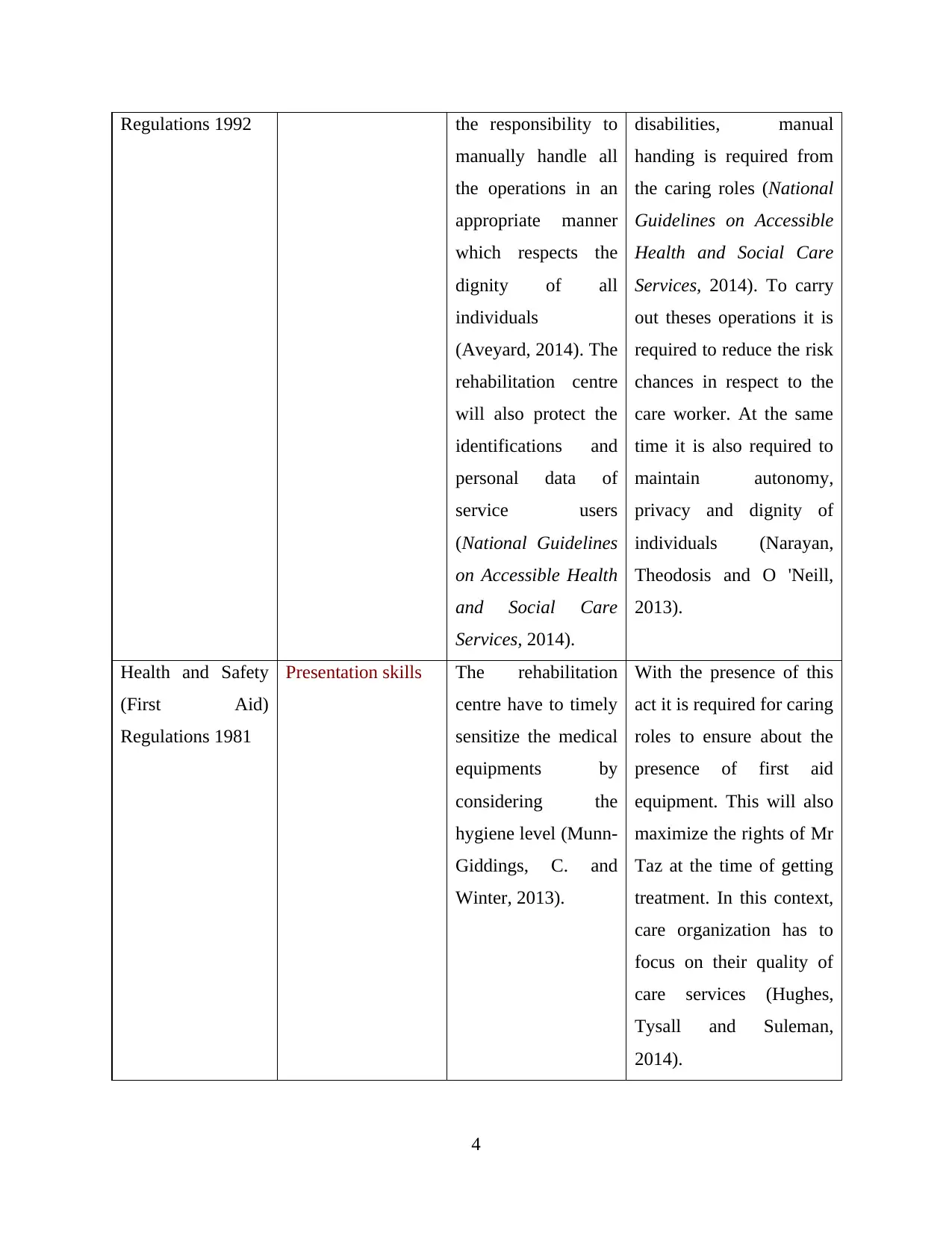
Regulations 1992 the responsibility to
manually handle all
the operations in an
appropriate manner
which respects the
dignity of all
individuals
(Aveyard, 2014). The
rehabilitation centre
will also protect the
identifications and
personal data of
service users
(National Guidelines
on Accessible Health
and Social Care
Services, 2014).
disabilities, manual
handing is required from
the caring roles (National
Guidelines on Accessible
Health and Social Care
Services, 2014). To carry
out theses operations it is
required to reduce the risk
chances in respect to the
care worker. At the same
time it is also required to
maintain autonomy,
privacy and dignity of
individuals (Narayan,
Theodosis and O 'Neill,
2013).
Health and Safety
(First Aid)
Regulations 1981
Presentation skills The rehabilitation
centre have to timely
sensitize the medical
equipments by
considering the
hygiene level (Munn-
Giddings, C. and
Winter, 2013).
With the presence of this
act it is required for caring
roles to ensure about the
presence of first aid
equipment. This will also
maximize the rights of Mr
Taz at the time of getting
treatment. In this context,
care organization has to
focus on their quality of
care services (Hughes,
Tysall and Suleman,
2014).
4
manually handle all
the operations in an
appropriate manner
which respects the
dignity of all
individuals
(Aveyard, 2014). The
rehabilitation centre
will also protect the
identifications and
personal data of
service users
(National Guidelines
on Accessible Health
and Social Care
Services, 2014).
disabilities, manual
handing is required from
the caring roles (National
Guidelines on Accessible
Health and Social Care
Services, 2014). To carry
out theses operations it is
required to reduce the risk
chances in respect to the
care worker. At the same
time it is also required to
maintain autonomy,
privacy and dignity of
individuals (Narayan,
Theodosis and O 'Neill,
2013).
Health and Safety
(First Aid)
Regulations 1981
Presentation skills The rehabilitation
centre have to timely
sensitize the medical
equipments by
considering the
hygiene level (Munn-
Giddings, C. and
Winter, 2013).
With the presence of this
act it is required for caring
roles to ensure about the
presence of first aid
equipment. This will also
maximize the rights of Mr
Taz at the time of getting
treatment. In this context,
care organization has to
focus on their quality of
care services (Hughes,
Tysall and Suleman,
2014).
4
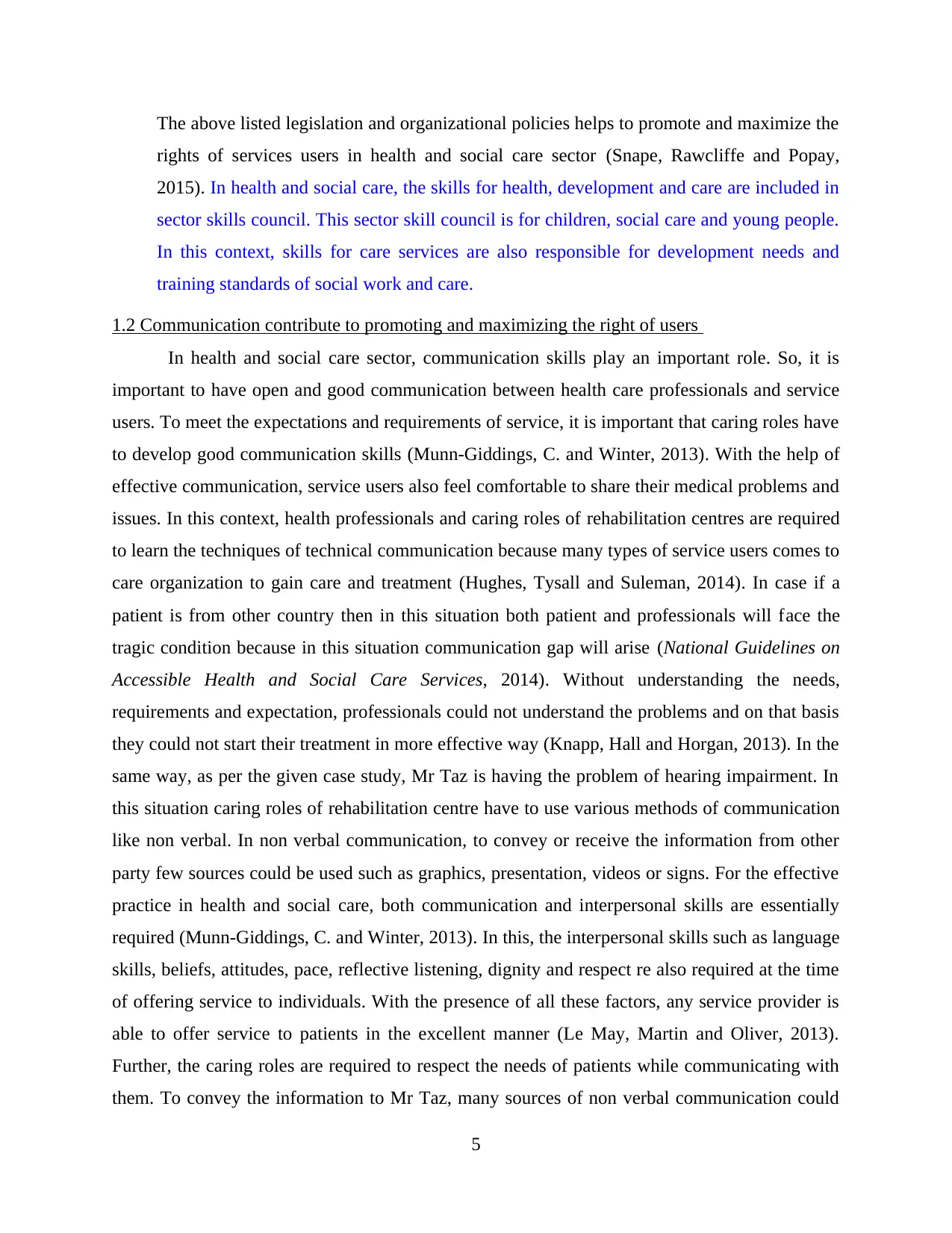
The above listed legislation and organizational policies helps to promote and maximize the
rights of services users in health and social care sector (Snape, Rawcliffe and Popay,
2015). In health and social care, the skills for health, development and care are included in
sector skills council. This sector skill council is for children, social care and young people.
In this context, skills for care services are also responsible for development needs and
training standards of social work and care.
1.2 Communication contribute to promoting and maximizing the right of users
In health and social care sector, communication skills play an important role. So, it is
important to have open and good communication between health care professionals and service
users. To meet the expectations and requirements of service, it is important that caring roles have
to develop good communication skills (Munn-Giddings, C. and Winter, 2013). With the help of
effective communication, service users also feel comfortable to share their medical problems and
issues. In this context, health professionals and caring roles of rehabilitation centres are required
to learn the techniques of technical communication because many types of service users comes to
care organization to gain care and treatment (Hughes, Tysall and Suleman, 2014). In case if a
patient is from other country then in this situation both patient and professionals will face the
tragic condition because in this situation communication gap will arise (National Guidelines on
Accessible Health and Social Care Services, 2014). Without understanding the needs,
requirements and expectation, professionals could not understand the problems and on that basis
they could not start their treatment in more effective way (Knapp, Hall and Horgan, 2013). In the
same way, as per the given case study, Mr Taz is having the problem of hearing impairment. In
this situation caring roles of rehabilitation centre have to use various methods of communication
like non verbal. In non verbal communication, to convey or receive the information from other
party few sources could be used such as graphics, presentation, videos or signs. For the effective
practice in health and social care, both communication and interpersonal skills are essentially
required (Munn-Giddings, C. and Winter, 2013). In this, the interpersonal skills such as language
skills, beliefs, attitudes, pace, reflective listening, dignity and respect re also required at the time
of offering service to individuals. With the presence of all these factors, any service provider is
able to offer service to patients in the excellent manner (Le May, Martin and Oliver, 2013).
Further, the caring roles are required to respect the needs of patients while communicating with
them. To convey the information to Mr Taz, many sources of non verbal communication could
5
rights of services users in health and social care sector (Snape, Rawcliffe and Popay,
2015). In health and social care, the skills for health, development and care are included in
sector skills council. This sector skill council is for children, social care and young people.
In this context, skills for care services are also responsible for development needs and
training standards of social work and care.
1.2 Communication contribute to promoting and maximizing the right of users
In health and social care sector, communication skills play an important role. So, it is
important to have open and good communication between health care professionals and service
users. To meet the expectations and requirements of service, it is important that caring roles have
to develop good communication skills (Munn-Giddings, C. and Winter, 2013). With the help of
effective communication, service users also feel comfortable to share their medical problems and
issues. In this context, health professionals and caring roles of rehabilitation centres are required
to learn the techniques of technical communication because many types of service users comes to
care organization to gain care and treatment (Hughes, Tysall and Suleman, 2014). In case if a
patient is from other country then in this situation both patient and professionals will face the
tragic condition because in this situation communication gap will arise (National Guidelines on
Accessible Health and Social Care Services, 2014). Without understanding the needs,
requirements and expectation, professionals could not understand the problems and on that basis
they could not start their treatment in more effective way (Knapp, Hall and Horgan, 2013). In the
same way, as per the given case study, Mr Taz is having the problem of hearing impairment. In
this situation caring roles of rehabilitation centre have to use various methods of communication
like non verbal. In non verbal communication, to convey or receive the information from other
party few sources could be used such as graphics, presentation, videos or signs. For the effective
practice in health and social care, both communication and interpersonal skills are essentially
required (Munn-Giddings, C. and Winter, 2013). In this, the interpersonal skills such as language
skills, beliefs, attitudes, pace, reflective listening, dignity and respect re also required at the time
of offering service to individuals. With the presence of all these factors, any service provider is
able to offer service to patients in the excellent manner (Le May, Martin and Oliver, 2013).
Further, the caring roles are required to respect the needs of patients while communicating with
them. To convey the information to Mr Taz, many sources of non verbal communication could
5
Paraphrase This Document
Need a fresh take? Get an instant paraphrase of this document with our AI Paraphraser
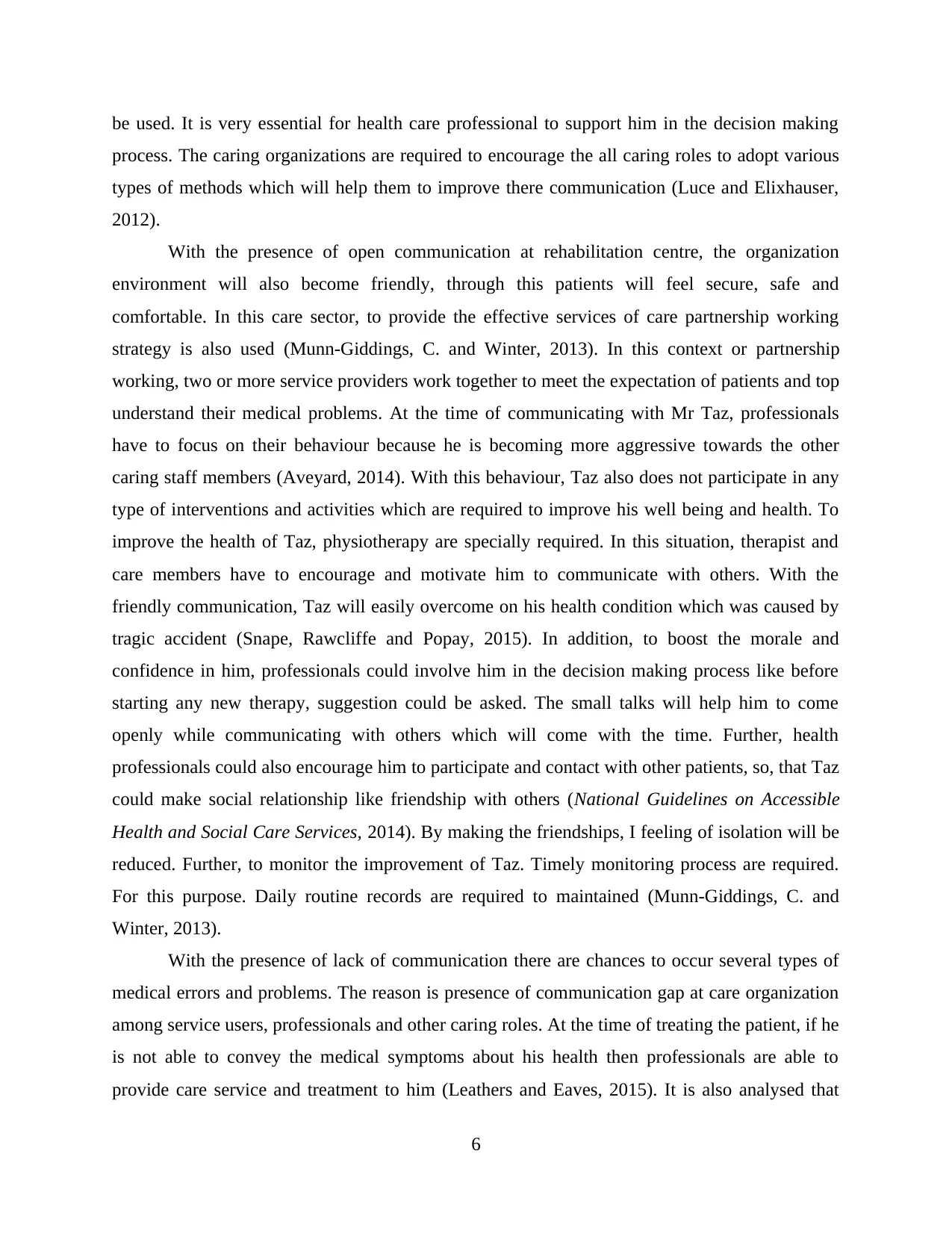
be used. It is very essential for health care professional to support him in the decision making
process. The caring organizations are required to encourage the all caring roles to adopt various
types of methods which will help them to improve there communication (Luce and Elixhauser,
2012).
With the presence of open communication at rehabilitation centre, the organization
environment will also become friendly, through this patients will feel secure, safe and
comfortable. In this care sector, to provide the effective services of care partnership working
strategy is also used (Munn-Giddings, C. and Winter, 2013). In this context or partnership
working, two or more service providers work together to meet the expectation of patients and top
understand their medical problems. At the time of communicating with Mr Taz, professionals
have to focus on their behaviour because he is becoming more aggressive towards the other
caring staff members (Aveyard, 2014). With this behaviour, Taz also does not participate in any
type of interventions and activities which are required to improve his well being and health. To
improve the health of Taz, physiotherapy are specially required. In this situation, therapist and
care members have to encourage and motivate him to communicate with others. With the
friendly communication, Taz will easily overcome on his health condition which was caused by
tragic accident (Snape, Rawcliffe and Popay, 2015). In addition, to boost the morale and
confidence in him, professionals could involve him in the decision making process like before
starting any new therapy, suggestion could be asked. The small talks will help him to come
openly while communicating with others which will come with the time. Further, health
professionals could also encourage him to participate and contact with other patients, so, that Taz
could make social relationship like friendship with others (National Guidelines on Accessible
Health and Social Care Services, 2014). By making the friendships, I feeling of isolation will be
reduced. Further, to monitor the improvement of Taz. Timely monitoring process are required.
For this purpose. Daily routine records are required to maintained (Munn-Giddings, C. and
Winter, 2013).
With the presence of lack of communication there are chances to occur several types of
medical errors and problems. The reason is presence of communication gap at care organization
among service users, professionals and other caring roles. At the time of treating the patient, if he
is not able to convey the medical symptoms about his health then professionals are able to
provide care service and treatment to him (Leathers and Eaves, 2015). It is also analysed that
6
process. The caring organizations are required to encourage the all caring roles to adopt various
types of methods which will help them to improve there communication (Luce and Elixhauser,
2012).
With the presence of open communication at rehabilitation centre, the organization
environment will also become friendly, through this patients will feel secure, safe and
comfortable. In this care sector, to provide the effective services of care partnership working
strategy is also used (Munn-Giddings, C. and Winter, 2013). In this context or partnership
working, two or more service providers work together to meet the expectation of patients and top
understand their medical problems. At the time of communicating with Mr Taz, professionals
have to focus on their behaviour because he is becoming more aggressive towards the other
caring staff members (Aveyard, 2014). With this behaviour, Taz also does not participate in any
type of interventions and activities which are required to improve his well being and health. To
improve the health of Taz, physiotherapy are specially required. In this situation, therapist and
care members have to encourage and motivate him to communicate with others. With the
friendly communication, Taz will easily overcome on his health condition which was caused by
tragic accident (Snape, Rawcliffe and Popay, 2015). In addition, to boost the morale and
confidence in him, professionals could involve him in the decision making process like before
starting any new therapy, suggestion could be asked. The small talks will help him to come
openly while communicating with others which will come with the time. Further, health
professionals could also encourage him to participate and contact with other patients, so, that Taz
could make social relationship like friendship with others (National Guidelines on Accessible
Health and Social Care Services, 2014). By making the friendships, I feeling of isolation will be
reduced. Further, to monitor the improvement of Taz. Timely monitoring process are required.
For this purpose. Daily routine records are required to maintained (Munn-Giddings, C. and
Winter, 2013).
With the presence of lack of communication there are chances to occur several types of
medical errors and problems. The reason is presence of communication gap at care organization
among service users, professionals and other caring roles. At the time of treating the patient, if he
is not able to convey the medical symptoms about his health then professionals are able to
provide care service and treatment to him (Leathers and Eaves, 2015). It is also analysed that
6
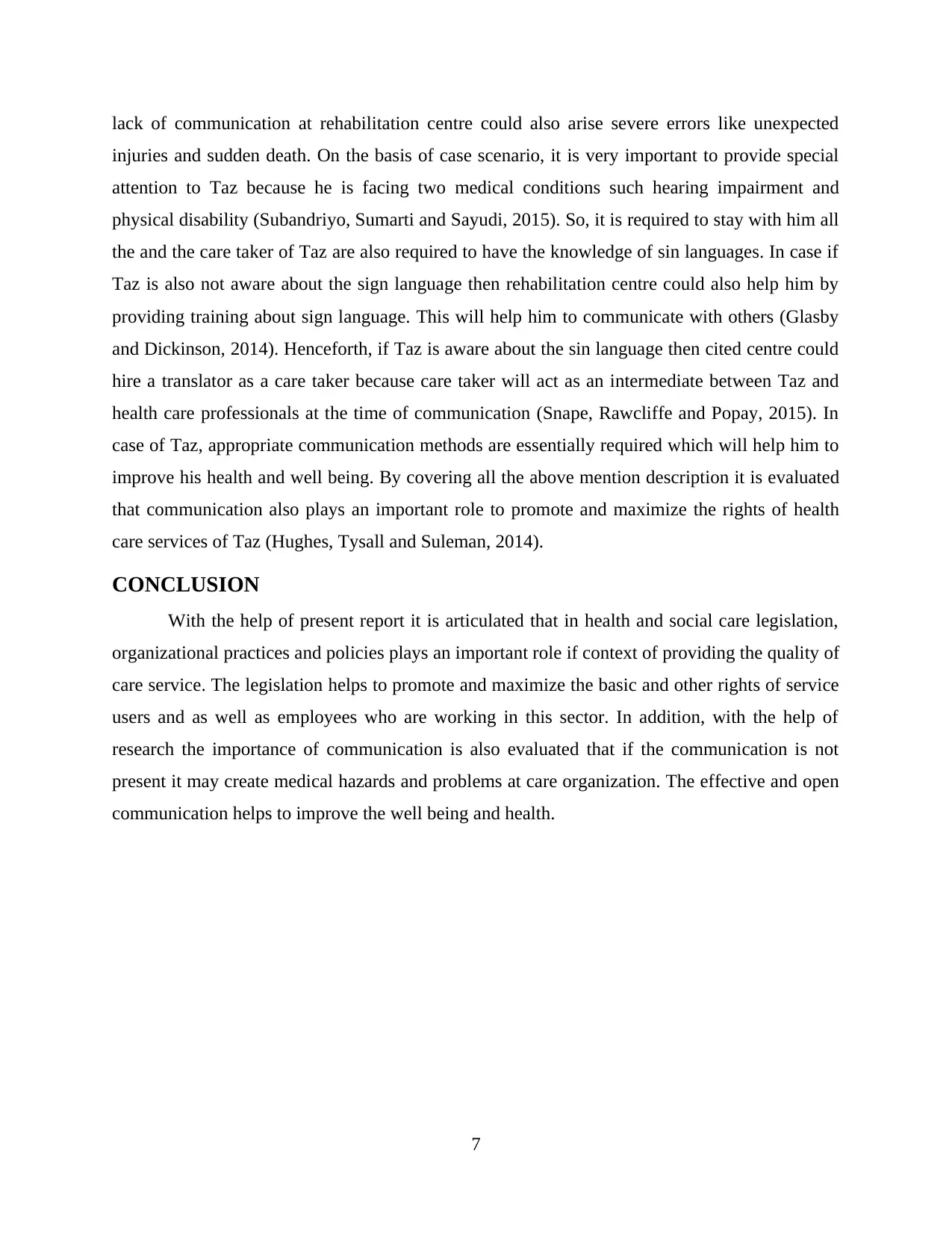
lack of communication at rehabilitation centre could also arise severe errors like unexpected
injuries and sudden death. On the basis of case scenario, it is very important to provide special
attention to Taz because he is facing two medical conditions such hearing impairment and
physical disability (Subandriyo, Sumarti and Sayudi, 2015). So, it is required to stay with him all
the and the care taker of Taz are also required to have the knowledge of sin languages. In case if
Taz is also not aware about the sign language then rehabilitation centre could also help him by
providing training about sign language. This will help him to communicate with others (Glasby
and Dickinson, 2014). Henceforth, if Taz is aware about the sin language then cited centre could
hire a translator as a care taker because care taker will act as an intermediate between Taz and
health care professionals at the time of communication (Snape, Rawcliffe and Popay, 2015). In
case of Taz, appropriate communication methods are essentially required which will help him to
improve his health and well being. By covering all the above mention description it is evaluated
that communication also plays an important role to promote and maximize the rights of health
care services of Taz (Hughes, Tysall and Suleman, 2014).
CONCLUSION
With the help of present report it is articulated that in health and social care legislation,
organizational practices and policies plays an important role if context of providing the quality of
care service. The legislation helps to promote and maximize the basic and other rights of service
users and as well as employees who are working in this sector. In addition, with the help of
research the importance of communication is also evaluated that if the communication is not
present it may create medical hazards and problems at care organization. The effective and open
communication helps to improve the well being and health.
7
injuries and sudden death. On the basis of case scenario, it is very important to provide special
attention to Taz because he is facing two medical conditions such hearing impairment and
physical disability (Subandriyo, Sumarti and Sayudi, 2015). So, it is required to stay with him all
the and the care taker of Taz are also required to have the knowledge of sin languages. In case if
Taz is also not aware about the sign language then rehabilitation centre could also help him by
providing training about sign language. This will help him to communicate with others (Glasby
and Dickinson, 2014). Henceforth, if Taz is aware about the sin language then cited centre could
hire a translator as a care taker because care taker will act as an intermediate between Taz and
health care professionals at the time of communication (Snape, Rawcliffe and Popay, 2015). In
case of Taz, appropriate communication methods are essentially required which will help him to
improve his health and well being. By covering all the above mention description it is evaluated
that communication also plays an important role to promote and maximize the rights of health
care services of Taz (Hughes, Tysall and Suleman, 2014).
CONCLUSION
With the help of present report it is articulated that in health and social care legislation,
organizational practices and policies plays an important role if context of providing the quality of
care service. The legislation helps to promote and maximize the basic and other rights of service
users and as well as employees who are working in this sector. In addition, with the help of
research the importance of communication is also evaluated that if the communication is not
present it may create medical hazards and problems at care organization. The effective and open
communication helps to improve the well being and health.
7
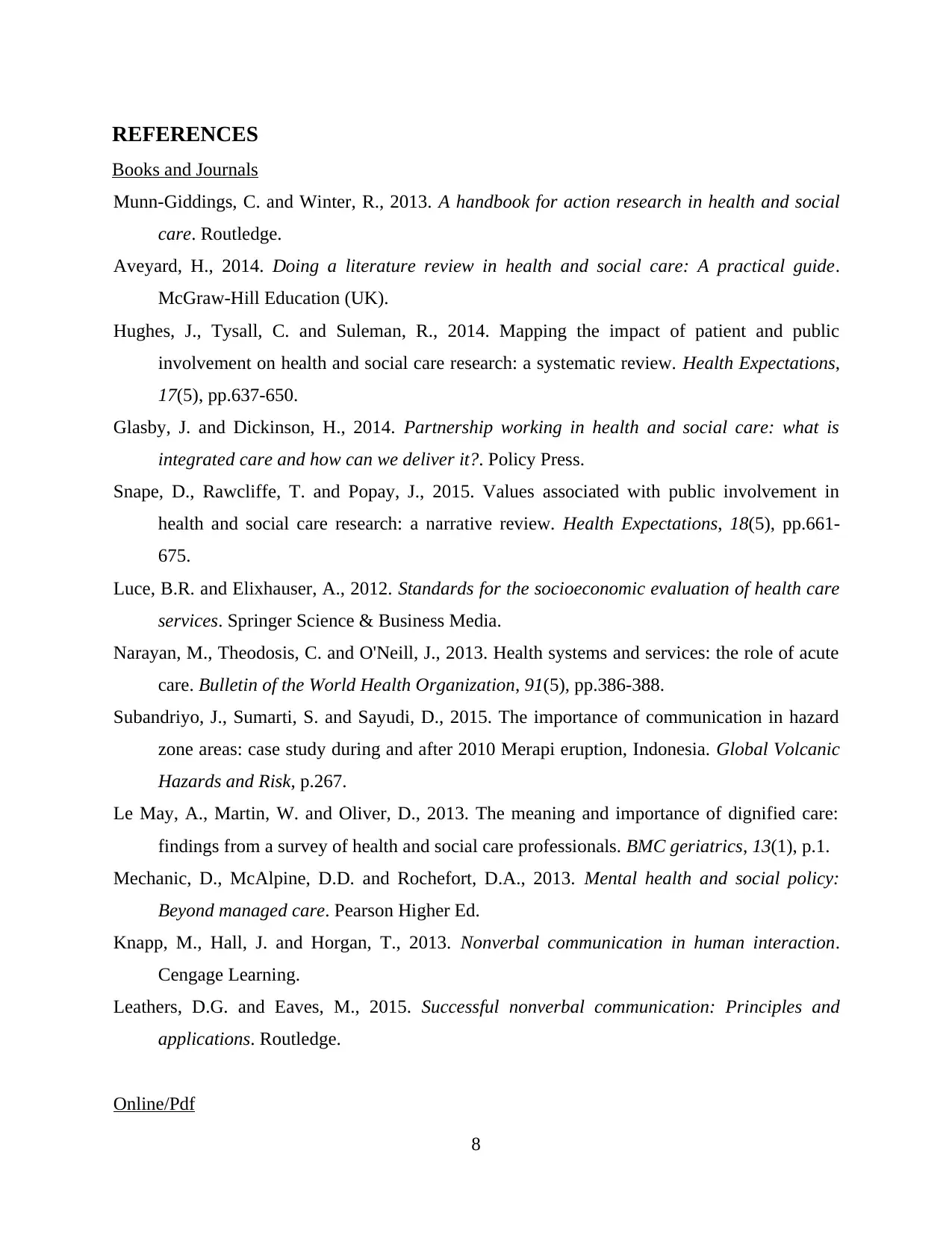
REFERENCES
Books and Journals
Munn-Giddings, C. and Winter, R., 2013. A handbook for action research in health and social
care. Routledge.
Aveyard, H., 2014. Doing a literature review in health and social care: A practical guide.
McGraw-Hill Education (UK).
Hughes, J., Tysall, C. and Suleman, R., 2014. Mapping the impact of patient and public
involvement on health and social care research: a systematic review. Health Expectations,
17(5), pp.637-650.
Glasby, J. and Dickinson, H., 2014. Partnership working in health and social care: what is
integrated care and how can we deliver it?. Policy Press.
Snape, D., Rawcliffe, T. and Popay, J., 2015. Values associated with public involvement in
health and social care research: a narrative review. Health Expectations, 18(5), pp.661-
675.
Luce, B.R. and Elixhauser, A., 2012. Standards for the socioeconomic evaluation of health care
services. Springer Science & Business Media.
Narayan, M., Theodosis, C. and O'Neill, J., 2013. Health systems and services: the role of acute
care. Bulletin of the World Health Organization, 91(5), pp.386-388.
Subandriyo, J., Sumarti, S. and Sayudi, D., 2015. The importance of communication in hazard
zone areas: case study during and after 2010 Merapi eruption, Indonesia. Global Volcanic
Hazards and Risk, p.267.
Le May, A., Martin, W. and Oliver, D., 2013. The meaning and importance of dignified care:
findings from a survey of health and social care professionals. BMC geriatrics, 13(1), p.1.
Mechanic, D., McAlpine, D.D. and Rochefort, D.A., 2013. Mental health and social policy:
Beyond managed care. Pearson Higher Ed.
Knapp, M., Hall, J. and Horgan, T., 2013. Nonverbal communication in human interaction.
Cengage Learning.
Leathers, D.G. and Eaves, M., 2015. Successful nonverbal communication: Principles and
applications. Routledge.
Online/Pdf
8
Books and Journals
Munn-Giddings, C. and Winter, R., 2013. A handbook for action research in health and social
care. Routledge.
Aveyard, H., 2014. Doing a literature review in health and social care: A practical guide.
McGraw-Hill Education (UK).
Hughes, J., Tysall, C. and Suleman, R., 2014. Mapping the impact of patient and public
involvement on health and social care research: a systematic review. Health Expectations,
17(5), pp.637-650.
Glasby, J. and Dickinson, H., 2014. Partnership working in health and social care: what is
integrated care and how can we deliver it?. Policy Press.
Snape, D., Rawcliffe, T. and Popay, J., 2015. Values associated with public involvement in
health and social care research: a narrative review. Health Expectations, 18(5), pp.661-
675.
Luce, B.R. and Elixhauser, A., 2012. Standards for the socioeconomic evaluation of health care
services. Springer Science & Business Media.
Narayan, M., Theodosis, C. and O'Neill, J., 2013. Health systems and services: the role of acute
care. Bulletin of the World Health Organization, 91(5), pp.386-388.
Subandriyo, J., Sumarti, S. and Sayudi, D., 2015. The importance of communication in hazard
zone areas: case study during and after 2010 Merapi eruption, Indonesia. Global Volcanic
Hazards and Risk, p.267.
Le May, A., Martin, W. and Oliver, D., 2013. The meaning and importance of dignified care:
findings from a survey of health and social care professionals. BMC geriatrics, 13(1), p.1.
Mechanic, D., McAlpine, D.D. and Rochefort, D.A., 2013. Mental health and social policy:
Beyond managed care. Pearson Higher Ed.
Knapp, M., Hall, J. and Horgan, T., 2013. Nonverbal communication in human interaction.
Cengage Learning.
Leathers, D.G. and Eaves, M., 2015. Successful nonverbal communication: Principles and
applications. Routledge.
Online/Pdf
8
Secure Best Marks with AI Grader
Need help grading? Try our AI Grader for instant feedback on your assignments.
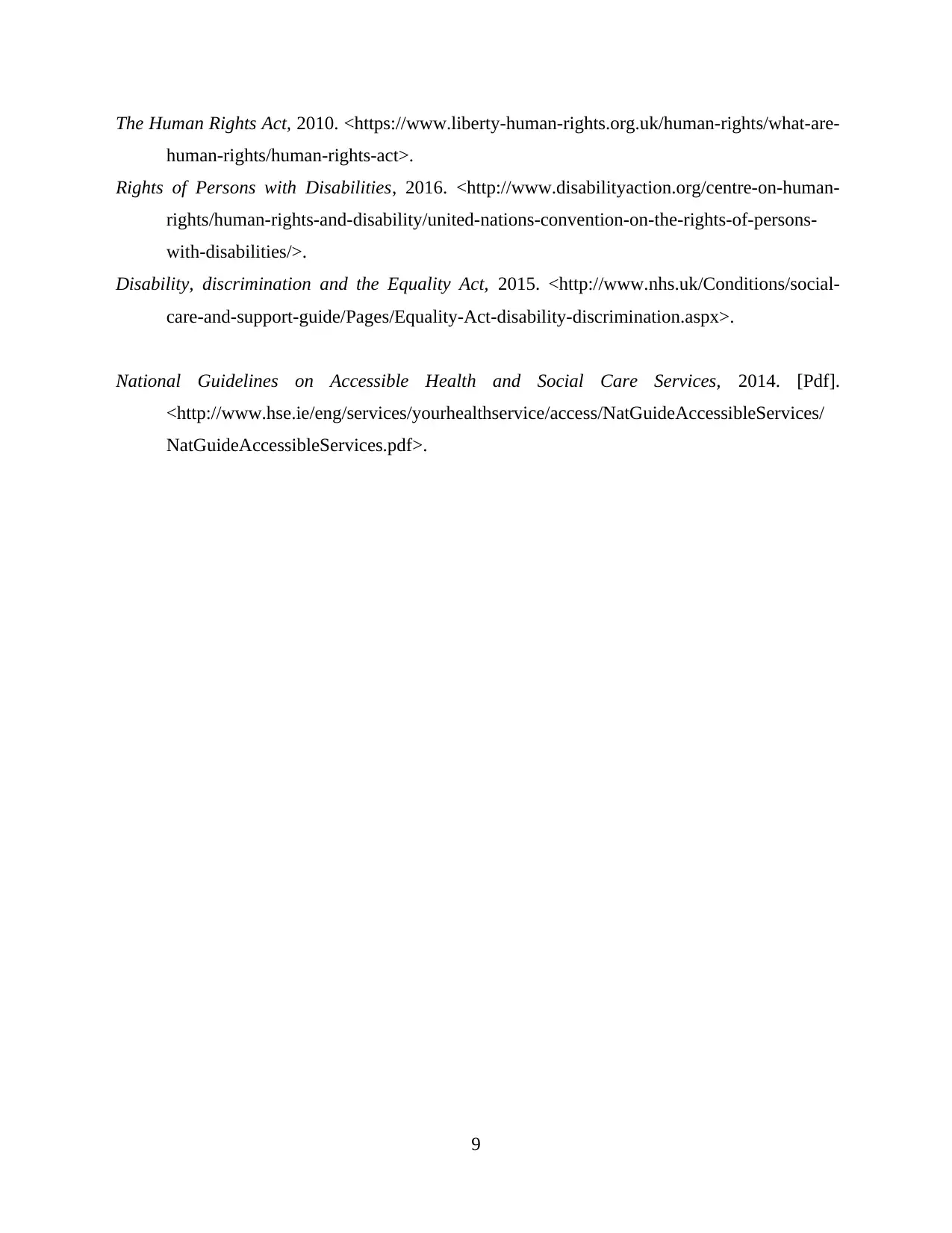
The Human Rights Act, 2010. <https://www.liberty-human-rights.org.uk/human-rights/what-are-
human-rights/human-rights-act>.
Rights of Persons with Disabilities, 2016. <http://www.disabilityaction.org/centre-on-human-
rights/human-rights-and-disability/united-nations-convention-on-the-rights-of-persons-
with-disabilities/>.
Disability, discrimination and the Equality Act, 2015. <http://www.nhs.uk/Conditions/social-
care-and-support-guide/Pages/Equality-Act-disability-discrimination.aspx>.
National Guidelines on Accessible Health and Social Care Services, 2014. [Pdf].
<http://www.hse.ie/eng/services/yourhealthservice/access/NatGuideAccessibleServices/
NatGuideAccessibleServices.pdf>.
9
human-rights/human-rights-act>.
Rights of Persons with Disabilities, 2016. <http://www.disabilityaction.org/centre-on-human-
rights/human-rights-and-disability/united-nations-convention-on-the-rights-of-persons-
with-disabilities/>.
Disability, discrimination and the Equality Act, 2015. <http://www.nhs.uk/Conditions/social-
care-and-support-guide/Pages/Equality-Act-disability-discrimination.aspx>.
National Guidelines on Accessible Health and Social Care Services, 2014. [Pdf].
<http://www.hse.ie/eng/services/yourhealthservice/access/NatGuideAccessibleServices/
NatGuideAccessibleServices.pdf>.
9
1 out of 11
Related Documents
Your All-in-One AI-Powered Toolkit for Academic Success.
+13062052269
info@desklib.com
Available 24*7 on WhatsApp / Email
![[object Object]](/_next/static/media/star-bottom.7253800d.svg)
Unlock your academic potential
© 2024 | Zucol Services PVT LTD | All rights reserved.





